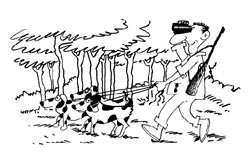Beware of Policymakers
 extinction is a nasty word one normally associates with lumbering gigantic lizards, huge prehistoric insects, dragon flies the size of a fighter plane or the Dodo. While humans had no say in the death of the dinosaur, they definitely played a major role in the death of the Dodo.
extinction is a nasty word one normally associates with lumbering gigantic lizards, huge prehistoric insects, dragon flies the size of a fighter plane or the Dodo. While humans had no say in the death of the dinosaur, they definitely played a major role in the death of the Dodo.
Today a policymaker, if given the chance to save the Dodo, would have the benefit of hindsight. All that would be required is to outlaw both dogs and guns in areas inhabited by the Dodo. The next step would be to introduce patrolling. Despite these efforts the Dodo might still have died out. Perhaps there is something wrong about the policy-makers' decision, which speed up the loss of biodiversity rather than reverse it.
Government laws can force farmers to adopt a particular plant variety or even a totally different crop from the one which sustains and is sustained by the area's ecosystem. This leads to genetic erosion of certain plant species and even livestock.
Decisions about intellectual property, particularly for plant life, have implications for food security and rural development in every country, specially in the developing world. From the early 1970s to the 1980s, governments pushed their farmers to use new high-yielding varieties, especially in the South, where populations are large and grain was the primary source of food. The 1970s were also the period when there was growing concern that an irreplaceable resource of genetic material was being lost at the cost of meeting food security objectives. In the mid-1970s there were only 10 countries with germplasm conservation programmes; 15 years later, more than 100 countries had outlined their strategies.
On December 29, 1993, the Convention on Biodiversity came into force. It attempts to provide a legally-binding framework to set up a system that will ensure that plant germplasm will be effectively conserved. They have brought with them a wide range of perspectives some essentially from an eco-conservation perspective, while others put genetic diversity conservation in the context of the need for empowerment of rural communities. All concur on the need to develop mutually-supporting systems.
The book provides essential information that will enable all of us to make up our minds on what should be done. It offers policymakers the options available and represents a wide cross-section of agricultural experience and national perspective. It includes grassroots organisers working with small-scale and subsistence farmers, research scientists and managers.
